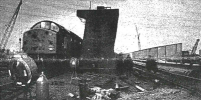LOOKING BACK: Besses o'th' Barn railway bridge celebrates 50th anniversary
IN the pouring November rain master engineer John Davies stood in quiet confidence as he prepared for his newest creation to face its ultimate test.
Despite its unromantic name, Bridge 26, which carries the Manchester to Bury line over the M62 at Besses o’th’ Barn,holds a special place in the engineer’s heart. And on November 9, 1969, the first train edged its way towards the structure.
Throughout its construction leading engineers warned that the project was a white elephant which would never stand nor carry a single train
But they were proven spectacularly wrong and since that date countless thousands of people have been ferried across the concrete and steel connection which next month celebrates its 50th anniversary.
At the time Welsh-born Mr Davies was one of British Rail’s youngest chartered civil engineers, and the conception of his design marked a milestone in his career, assuring either a bright future or crestfallen ignominy.
Construction of the bridge put Besses on the civil engineering map, in part thanks to Mr Davies’ unusual and ground breaking design, but primarily because of the huge difficulties British Rail surmounted to ensure its completion.
A myriad of obstacles confronted engineers and construction workers on the bumpy road to the project’s realisation, from technical quibbles over concrete strengths and mixing, to a crack in the titanic support blocks.
Such was the mounting headache that as work progressed British Rail summoned a conference of experts to Derby to solve their problems.
Amidst the head scratching technical magazines from as far away as Europe and the USA marvelled at the the scale of materials needed - 7,500 tons of concrete, 500 tons of high tensile steel reinforcements, and 60 miles of prestressing rods and strands for the rail bridge alone.
At the same time the simultaneous construction of the road bridge saw some 4,000 cubic yards of earth removed for 3,000 tons worth of concrete foundations. While the main structure weighed more than 1,000 tons.
Whereas this staggering assembly of material gave the road bridge a bearing capacity of 150 to 300 tons, its gigantic railway sister boasted a whopping 3,600 tonnage.
But, in spite of the challenges, one by one they were overcome and the bridge took shape.
By November, 1969, it was up. But questions remained about whether it would stay up.
As Armistice Day dawned the answer would be found, just 12 hours before the first passenger service was scheduled to cross.
Not untypical Lancashire rain fell as Mr Davies oversaw permanent way gangs relay the tracks while a ballast train waited all day just out of sight.
As the gloom of autumnal dusk fell Mr Davies signalled the driver. The locomotive trundled to the very brink of the crossing before lurching to an anxious halt.
“Is it safe?” the apprehensive driver called.
“Of course it is,” Mr Davies assured him.
Then striding to the middle of the vast structure he jumped up and down to reassure him even further.
His fears were soothed. And with that the driver began to creep his train forward and Bridge 26 was in business.
Speaking to the Bury Times, Mr Davies said: “In light of the prediction by many well known engineers that the bridge would not stand up let alone carry trains, you can imagine my pleasure as its 50th birthday approaches
“I have just celebrated my 80th birthday and I am grateful for the opportunity I had to contribute to the creation of the infrastructure that it so vital to us all.”
Besses, however, was not the end of the line for Mr Davies who left British Rail on its completion to to supervise construction of on the bridge over the River Thames at Marlow.
In 1982 he was then appointed the director of engineering for the Royal Borough of Kensington and Chelsea and was responsible for a number of further bridges over the Thames, including the Albert Bridge which has featured in the Stanley Kubrick film A Clockwork Orange and musical Absolute Beginners, among others.
However, Mr Davies sentimental connection to Bridge 26 extends even further as his wife Judith was born and lived in Prestwich for over 20 years, and he says the Besses rail bridge is “not far from our minds” when visiting relatives in Lancashire.



